Cavazos-Oto: Strength domain
Rationale
The purpose of these tests is to measure maximum force output of the majority of the body’s muscles.
Strength is tested with four basic lifts: the standard barbell deadlift (posterior chain), the barbell front squat (anterior chain), the standing barbell shoulder press (upper body push), and the weighted pullup (upper body pull, as well as a bodyweight exercise). These are basic compound movements that require strength from virtually the entire body, yet are not likely to be limited by skill or other factors.
It is assumed that most worthwhile athletic activities requiring strength can be represented by the strength expressed with these four lifts. Barbells are emphasized due to their ubiquity and ease of scaling and measurement.
Guidelines
To record a valid score in the Strength domain, all of the tests here must be completed within the 1-month timeframe. They need not be tested in a single session nor in any particular order.
Chalk, lifting belts, non-constricting knee wraps, and most non-performance-enhancing paraphernalia are allowed, including any type of shoes and normal clothing. Explicitly disallowed are restrictive powerlifting suits (squat suits, bench shirts, etc.), wrist straps for the deadlift or pullup, and other assistive gear. If a spotter touches the lifter or weight at any point during a lift, it is disqualified.
A “0” score is awarded if a lifter can move a stick, plastic pipe, or other object of trivial weight. Weight between 0 and 45lb (a standard unloaded bar) can be tested using micro-weights, or whatever is available.
Test one: Deadlift
Load a 20kg barbell at standard height (radius of a 45lb plate) from the ground. Using a stance that places the hands outside the knees, lift the bar in one motion until the knees and hips are fully extended with the back in normal extension. Lower the weight back to the floor. Increase weight until a one-repetition maximum (1RM) is found. This weight in pounds is your score.
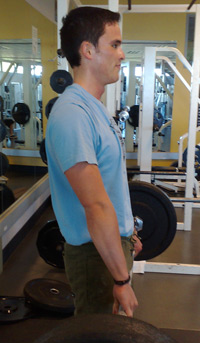
Top position
Each rep must start and end on the floor; the bar may be lowered at any speed but must remain in the hands. The lift need not be paused in the top position.
The sumo stance, with hands inside the legs, is not permitted; however, as long as the hands grip the bar outside of the shins, any width or angulation of the feet is allowed. Any grip is allowed, including overhand, hooked, or mixed.
| Sub-athletic | |||||||||||
|---|---|---|---|---|---|---|---|---|---|---|---|
| 0 | 1 | 2 | 3 | 4 | 5 | 6 | 7 | 8 | 9 | 10 | ranking |
| 0 | 50 | 100 | 200 | 300 | 400 | 500 | 600 | 700 | 800 | 900 | pounds |
Test two: Front squat
Load a 20kg barbell in a squat rack. Rack the bar across the front of the shoulders, step back, and perform a front squat. Upon completion, rerack the weight. Increase weight until a one-repetition maximum (1RM) is found. This weight in pounds is your score.
Each rep must descend below parallel, which is defined as the depth at which the visible crease of the hip breaks the horizontal plane of the top of the patella. The top of the lift is complete when the lifter fully extends the knees and hips with the back in normal extension. The barbell must rest on the front of the shoulders, anterior to the neck; any grip is allowed, including a clean-style grip, clean grip with straps, or arms crossed. Any width or angulation of the feet is permitted, but the feet must remain motionless once the squat begins.

Top position
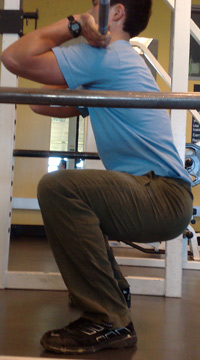
Past parallel; minimum acceptable depth
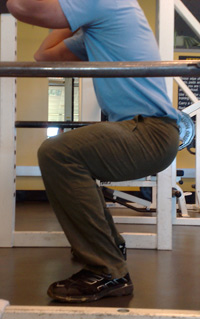
Above parallel; not a valid attempt
The squat may be performed at any speed and may pause at any point, but may not reverse directions except at the bottom.
Neither the bar nor the athlete may come into contact with any extraneous object between racking and unracking the weight. Impacting the rails of a power cage, squatting to a box or ball, or assistance from a spotter are not allowed.
If a squat rack is unavailable, it is permissible to clean the barbell from the floor, as long as the same motionless stance and rack position is assumed prior to beginning the squat.
| Sub-athletic | |||||||||||
|---|---|---|---|---|---|---|---|---|---|---|---|
| 0 | 1 | 2 | 3 | 4 | 5 | 6 | 7 | 8 | 9 | 10 | ranking |
| 0 | 25 | 50 | 131.25 | 212.5 | 293.75 | 375 | 456.25 | 537.5 | 618.75 | 700 | pounds |
Test three: Shoulder press
Load a 20kg barbell in a squat rack. Take the bar in the hands at the front of the chest, step back, and perform a standing shoulder press. Upon completion, rerack the weight. Increase weight until a one-repetition maximum (1RM) is found. This weight in pounds is your score.
Each rep must begin and end with the bar touching the chest, and at the top of the lift the elbows must reach full extension. The weight need not be paused in the top position, but it must be stable and under control. Any width of grip is allowed. The bar may be raised and lowered at any speed but may not reverse directions except at the top.
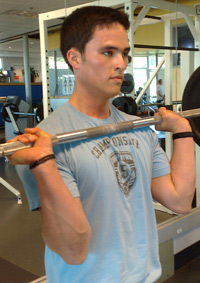
Starting rack, bar touching chest
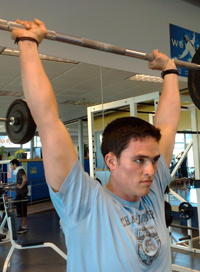
Top position, elbows fully extended
The lower body must be completely locked during the entire lift; any flexion of the knees or hips disqualifies the lift. A severe body layback that brings the front of the armpits rearward of the buttocks at any point during the lift will disqualify the attempt. Any width or angulation of the feet is permitted, but the feet must stay motionless once the bar begins to move.
Neither the bar nor the athlete may come into contact with any extraneous object between racking and unracking the weight.
If a squat rack is unavailable, it is permissible to clean the barbell from the floor, as long as the same motionless stance and rack position is assumed prior to beginning the press.
| Sub-athletic | |||||||||||
|---|---|---|---|---|---|---|---|---|---|---|---|
| 0 | 1 | 2 | 3 | 4 | 5 | 6 | 7 | 8 | 9 | 10 | ranking |
| 0 | 25 | 50 | 106.25 | 162.5 | 218.75 | 275 | 331.25 | 387.5 | 443.75 | 500 | pounds |
Test four: Weighted pull-up
Load your body with a weight and grasp a pullup bar with an overhand, pronated grip. Beginning from a motionless dead hang, pull your body up until the tip of your chin breaks the horizontal plane of the top edge of the bar. Lower back to a full hang. Increase weight until a one-repetition maximum (1RM) is found.
Weigh yourself with any accurate scale. Your total score is your bodyweight + your added weight, or the total weight in pounds you moved in a successful pullup.
Any type of bar (padded, metal, ledge) and hand width (wide, narrow, moderate) may be used, but the grip must be overhand, with the palms facing directly forward. Thumbs may be on either side of the bar. Each rep must begin with the athlete fully suspended with complete extension of the elbows and shoulders, in contact with nothing but the bar, fully supporting any added weight, and free from any swing. The pull may be performed at any speed, and may pause at any point, but may not descend prior to reaching full height, may not be assisted with any swing, kicking, or arching of the body, and may not bring the athlete in contact with anything except the bar. If the bar is low enough for the athlete to touch the ground when hanging, he must bend his legs or hips enough to stay suspended and meet these requirements. No straps or grips may be used to secure the hands to the bar, but chalk is allowed.

Starting position; dead hang with elbows and shoulders fully extended

Unacceptable starting position; elbows and shoulders flexed
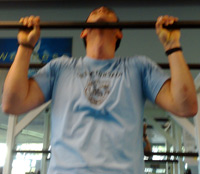
Top position; tip of chin over top of bar
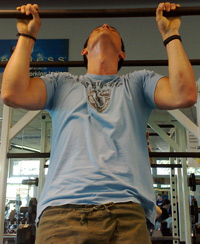
Unacceptable top position; tip of chin below top of bar
It is permissible to extend the neck to raise the chin, but it is absolutely forbidden to kip or “hitch” the body to extend the top of the pull.
Weight may be attached in any method, so long as it is affixed below the elbows. Suggestions are:
- Plates secured to a waistbelt with chain or rope
- Backpack or weighted vest
- Dumbbell held in the feet, knees, or thighs
- Kettlebells hooked in the feet
- Combinations of the above
If the athlete is unable to perform a single bodyweight pullup, he may use a Gravitron or other assistance device, and subtract the assisting load from his bodyweight for a score.
| Sub-athletic | |||||||||||
|---|---|---|---|---|---|---|---|---|---|---|---|
| 0 | 1 | 2 | 3 | 4 | 5 | 6 | 7 | 8 | 9 | 10 | ranking |
| 0 | 50 | 100 | 150 | 200 | 250 | 300 | 350 | 400 | 450 | 500 | pounds |
Total strength score
The below number is the average of the rankings calculated above. Nothing complicated is being done; the numbers output by the above tests are simply being averaged for your convenience. This average is displayed automatically; however, as described in the instructions, your Strength score will not be valid until you have completed all of the above tests, even if a number is displayed below prior to that. This is simply a limitation of the calculation widget’s intelligence.
» Strength score: «